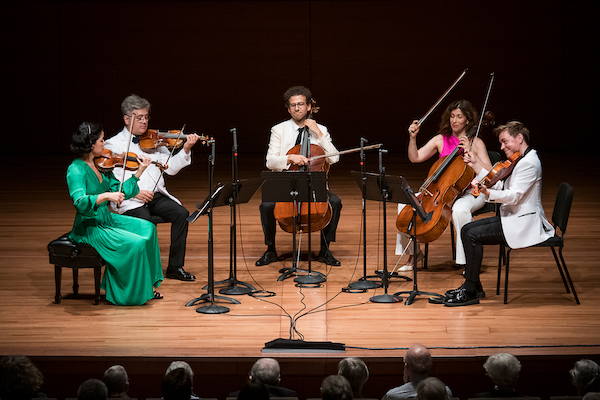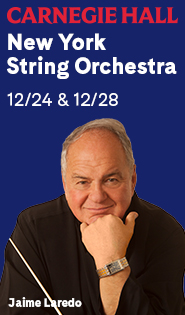Vibrant strings are the thing to open Chamber Music Society’s summer series

Lincoln Center may be promoting warm-weather outdoor fun these days, but chamber music still sounds best in a chamber. So this month the Chamber Music Society of Lincoln Center is inviting listeners into air-conditioned Alice Tully Hall to, well, chill to the music of the masters.
Sunday afternoon’s concert, the first of four over a nine-day period, set a summery, upbeat tone for the series with pieces for strings by Boccherini, Beethoven and Glazunov (written, coincidentally, when the composers were 28, 28, and 27 years old respectively). But though the mood was relaxed, these composers gave the listener plenty to chew on, and the CMS players took care not to relax their standards of polished tone and attention to detail.
For its part, the near-capacity audience evidently consisted mainly of old-school chamber music lovers rather than walk-ins from the plaza; listeners religiously held their applause till the end of the work no matter how snazzy the first-movement coda or how dazzling the scherzo.
“If music be the food of love, play on” could be the motto of the first movement of Boccherini’s String Quintet in E major, Op. 11, no. 5, marked Amoroso by the composer and played with string-cushioning mutes throughout. In Sunday’s elegant performance—by violinists Jennifer Frautschi and Aaron Boyd, violist Matthew Lipman, and cellists Inbal Segev and Nicholas Canellakis—the influence of the Spanish royal court could be heard in the suavely dancing theme in thirds and the smoky Iberian harmonies. Near movement’s end, one heard the composer, a cello virtuoso himself, amusingly challenging the court cellist to a two-cello climb up the fingerboards into sky-high violin range.
Mutes came off for the Allegro con spirito, a folk dance with a robust two-cello foundation and catch-me-if-you-can imitation in the upper parts. Dissonant clashes in the counterpoint gave the music a gypsy-style bite and energy.
Mutes returned to create the satiny sound of the Minuetto, an almost too famous piece, here freed from its multiple arrangements and extramusical associations to glow gently with the original syncopated violin tune and delicate pizzicato accompaniment. Rising staccato lines added a touch of rustic contrast in the trio.
The theme of the rondo finale, not particularly memorable in itself, got into one’s head after a while, thanks in part to the players’ cunning ways of signaling its return. The eventful movement, full of sudden harmonic turns and bursts of activity, wrapped up with a playful coda that brought delighted applause.
As a rising music star in his twenties, Beethoven established a pattern of publishing solo sonatas and chamber works in groups of three, arranged to show their contrasting character and the composer’s various solutions to Classical four-movement form. Though cast as the modest middle child of the Op. 9 string trios, No. 2 in D major packs a lot of activity into its Allegretto first movement—especially on Sunday with violinist Boyd leading the way in spirited, impeccably-tuned flights up the fingerboard.
In fact, Sunday’s performance was notable not just for expert ensemble playing but for the individual character of each voice: Boyd fluid and silvery as a mountain stream, cellist Canellakis gruff or resonant as required, and violist Lipman a strong, eminently reasonable mediator between the two.
The similar markings of the movements—Allegretto for the first, Andante quasi allegretto for the second—illustrated how elastic Beethoven’s idea of allegretto was: brilliant and active in the first movement, but tender and tentative later. Gently driven at first by cello pizzicato, the slow movement drifted into the subjective world of Beethoven’s frequent pauses, sensitively and unanimously executed by the three players.
Ornate scale passages decorated the main theme of the capricious Menuetto, while the trio section’s soft, furtive staccato gave a foretaste of suspenseful passages in the Fifth Symphony. The closing Rondo featured cordial interplay between cello and viola, and a vividly rendered assortment of episodes from whimsical to resonant to flashy—a tribute to Beethoven’s inexhaustible imagination.
Alexander Glazunov’s two-cello String Quintet in A major, Op. 39, composed in 1891-92, brought the Boccherini players back together, but shuffled, with Boyd leading the violins this time and Canellakis the cellos. The composer’s musical influences seemed somewhat shuffled as well, from the first movement’s Tchaikovsky-like surges and concerto-style writing for violin to the scherzo’s modern-sounding all-pizzicato counterpoint, and from the yearning Romanticism of the Andante sostenuto to the heavy-booted Russian nationalism of the folk-dance finale.
Half again as long in performance as the Boccherini or the Beethoven, Glazunov’s score seemed to wander at times, but, by giving each episode its own color and voice, the CMS players held it all together, so that the finale’s last acceleration to Prestissimo seemed not tacked on but fitting.
The Chamber Music Society’s next program will include works of Saint-Saëns, Dukas, Françaix, Poulenc, and Rimsky-Koraskov, 7:30 p.m. Tuesday. chambermusicsociety.org.
